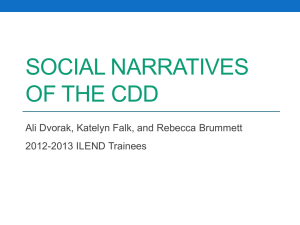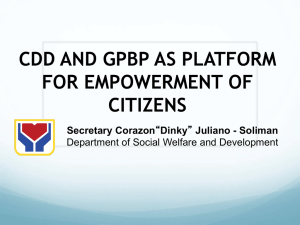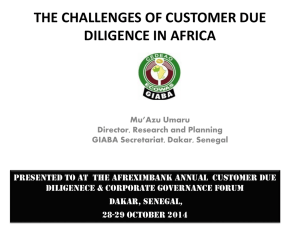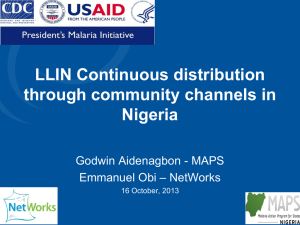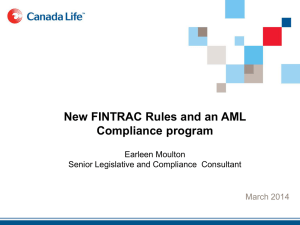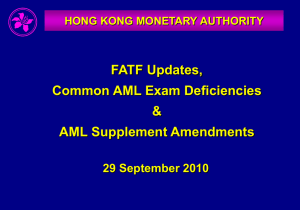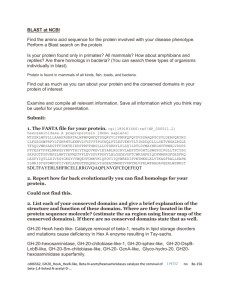The Right Framework for CDD in Africa - African export
advertisement
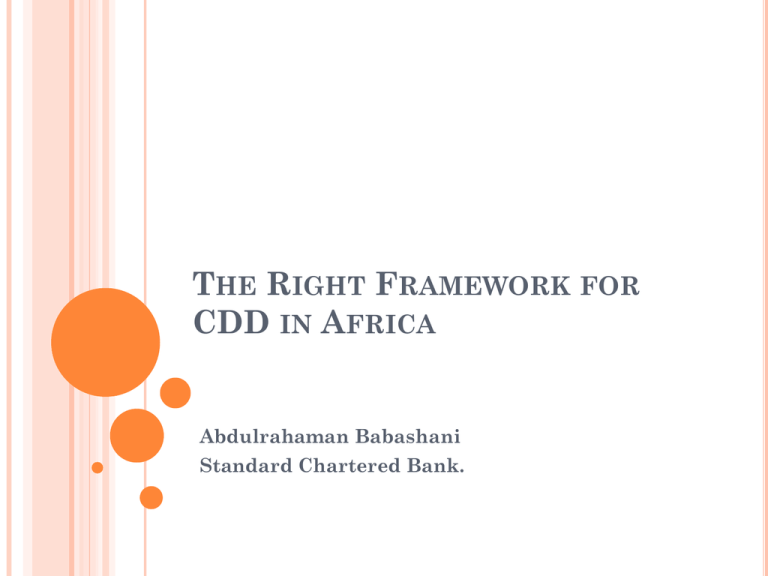
THE RIGHT FRAMEWORK FOR
CDD IN AFRICA
Abdulrahaman Babashani
Standard Chartered Bank.
OUTLINE
Customer Due Diligence
CDD Framework: International Best Practice
CDD Frameworks: A comparative analysis
Challenges of applying CDD measures in Africa
What works best for Africa
Conclusion
INTRODUCTION: WHAT IS CDD?
Customer Due Diligence (CDD) is a fundamental principle
of all Anti Money Laundering (AML) controls.
CDD formerly known as Know Your Customer (KYC)
represents the process responsible for maintaining controls
in an FI. It serves as the due diligence that the bank must
perform to identify our customers and ascertain relevant
information pertinent to doing financial business with our
potential customers.
In short, CDD is the collation as well as verification of
relevant information and documents required to meet
current regulatory standards, keeping in mind the
importance of identifying any potential risks to the bank in
terms of identify theft, fraud, money laundering and
terrorist financing that may arise while taking on a
customer
CDD comprises:
o Identifying the client and verifying their identity on
the basis of documents, data or information
obtained from a reliable and independent source,
o
Identifying, where there is a beneficial owner who is
not the client, the beneficial owner and taking
adequate measures, on a risk-sensitive basis, to
verify his identity so that you are satisfied that you
know who the beneficial owner is. This includes
understanding the ownership and control structure
of a legal person, trust or similar arrangement.
o
Obtaining information on the purpose and intended
nature of the business relationship.
CDD FRAMEWORK: INTERNATIONAL
BEST PRACTICE
FATF, Recommendation 5 asks that:
Financial institutions should be required to undertake customer
due diligence (CDD) measures when:
(i)
establishing business relations;
(ii) carrying out occasional transactions: (i) above the applicable designated
threshold (USD/EUR 15,000); or (ii) that are wire transfers in the
circumstances covered by the Interpretive Note to Recommendation 16;
(iii) there is a suspicion of money laundering or terrorist financing; or
(iv) the financial institution has doubts about the veracity or adequacy of
previously obtained customer identification data.
The FATF further recommends that each
Country should set out in their laws provisions
for CDD, which should serve as a guide for
developing
Regulatory
and
Institutional
frameworks for same.
A Country may determine how it imposes specific
CDD obligations, either through law or enforceable
means.
Also, Financial institutions should be required by law
to maintain records on transactions and information
obtained through the CDD measures.
International Anti-Money Laundering/Combating the
Financing of Terrorism (AML-CFT) standards require
that adequate customer due diligence (CDD) be
undertaken on all new accounts and on single payment
cash operations to identify suspicious transactions.
National laws and regulations, particularly in Africa
typically require verification of:
(i) client identity using an official document; and
(ii) Client’s physical address.
With regard to customer identification, financial
institutions may be able to apply differentiated
CDD measures according to the profile of the
(future) customer.
CDD requirements are intended to ensure that
financial institutions can effectively identify,
verify and monitor their customers and the
financial transactions in which they engage, in
relation to the money laundering and terrorism
financing risks that they pose.
WHEN CAN CDD BE PERFORMED
The FATF specifically requires all financial
institutions that are subject to AML/CFT
obligations to implement CDD measures,
including identifying and verifying the identity of
their customers, when:
Establishing business relations;
Carrying
out
occasional
transactions
above
USD/EUR 15 000 or that are wire transfers in the
circumstances covered by the Interpretive Note to
Recommendation 16;
There is a suspicion of money laundering or terrorist
financing; or
The financial institution has doubts about the
veracity or adequacy of previously obtained customer
identification data.
In recognition of Financial Inclusion, FATF
allows for simplified – though neither an absence
nor an exemption from – CDD measures where
there is a lower risk of ML/TF.
Simplified CDD standards can be decided at
country level, based on risk or at financial
institution level.
Strict documentary requirements for opening an
account may exclude workers active in rural
areas or in the informal economy, who are less
likely to have wage slips or formal proof of
domicile.
In
Sub-Saharan
Africa,
documentation
requirements potentially reduce the share of
adults with an account by up to 23%.
Financial Inclusion is seen as a tool to further
strengthen AML/CTF Frameworks.
CDD FRAMEWORKS: A COMPARATIVE
ANALYSIS
S/No
Country
Are there minimum
transaction thresholds,
under which customer
due diligence is not
required?
In what circumstances are
reduced/simplified due
diligence arrangements
available?
In what circumstances are
enhanced customer due
diligence measures
required?
1
South Africa
No - Due diligence (DD) is
always required for all
client relationships and
single transactions,
irrespective of the value
involved. However the
law does make provision
for certain exemptions
where a reduced level of
DD is permitted.
Depending on the risk profile,
the level of DD is simplified
for low risk clients or in
respect of existing clients who
are applying for different
products
The FICA Guidance notes
state that accountable
institutions should follow a
risk-based approach to
CDD. Clients are given a
risk-rating based on various
risk factors. High-risk client
types and high risk
transactions and services
warrant EDD procedures.
2
Ghana
Yes – equivalent of USD
10, 000.
None.
Enhanced CDD is required
when dealing with PEPs.
3
Cote D’Ivoire
No - there are no
minimum transaction
thresholds under which
customer due diligence is
not required.
CDD arrangements are
reduced for low value
transactions.
CDD is enhanced for
unusual or suspicious
activities/transactions.
S/No
Country
Are there minimum
transaction thresholds,
under which customer due
diligence is not required?
In what circumstances are
reduced/simplified due
diligence arrangements
available?
In what circumstances are
enhanced customer due
diligence measures
required?
4
USA
No - basic DD is required
for all accounts/customers
regardless of transaction
amounts.
At a minimum, a FI must obtain
the following identifying
information from each
customer before opening an
account:
a) name
b) address
c) date of birth (for individuals)
d) identification number (e.g.
Taxpayer Identification
Number (TIN) or passport
number)
The USA PATRIOT Act
requires FIs to increase their
due diligence standards
when dealing with foreign
private banking &
correspondent accounts. In
addition, customers
classified as high risk
according to the FI’s
customer risk rating
methodology would be
subject to EDD.
S/No
Country
Are there minimum
transaction thresholds,
under which customer due
diligence is not required?
In what circumstances are
reduced/simplified due
diligence arrangements
available?
In what circumstances are
enhanced customer due
diligence measures required?
5
UK
Yes - one off transactions
below EUR15,000
Simplified DD may be applied
to:
a) certain other regulated firms
in the financial sector;
b) companies listed on a
regulated market;
c) beneficial owners of pooled
accounts held by notaries or
independent legal professionals;
d) UK public authorities;
e) community institutions;
f) certain life assurance and eMoney products;
g) certain pension funds;
h) certain low risk products; and
i) child trust funds and junior
ISAs.
A firm must apply, on a risksensitive basis, enhanced CDD
measures and enhanced
ongoing monitoring in any
situation which by its nature
can present a higher risk of
money laundering or terrorist
financing. Three specific types
of relationships where EDD
measures must be applied
are:
a) where the customer has
not been physically present
for identification purposes; or
b) in respect of a
correspondent banking
relationship with Respondents
from non- European
Economic Area ('EEA') states;
or
c) in respect of a business
relationship or an occasional
transaction with a PEP.
CHALLENGES OF APPLYING CDD
MEASURES IN AFRICA
Poor public records;
Lack of adequate KYC/CDD documentary evidence;
Inability of FIs to effectively identify customers;
Difficulty in conducting assessment required for risk
rating (Risk Based Approach);
Striking a balance between AML/CFT requirements
and Financial inclusion;
Poor understanding of CDD Principles by non-bank
stakeholders, i.e. Mobile Money Agents;
Difficulty in knowing when to transit from CDD to
EDD;
Knowing which CDD framework to adopt
GENERAL CHALLENGES OF IMPLEMENTING
CDD (CONT’D)
Technological challenges and lack of harmonized data bank
compatibility
with law
Corrupt Tendencies of FI customers document counterfeiting
Lack of Cooperation between Regulators and FI
Maintaining common KYC standards in overseas offices
Conflict of interest and the need to increase rural banking
Stringent CDD could discourage small businesses and
disadvantageous persons e.g. minors and the blind.
Often receiving opinions differing in their interpretation of the
law/regulation.
GENERAL CHALLENGES OF IMPLEMENTING
CDD (CONT’D)
Incompatibility of the FATF recommendations with local
requirements.
Legal restrictions that impede effective consolidated KYC
risk management processes should be removed.
The difficulty with obtaining information on beneficial
ownership
Constraints in International Cooperation and law
enforcement
The craze for deposit liability and unrealistic targets
Competition and lack of cooperation among financial
institutions
The problem of similarity in a names in the name
checking list.
Staff fidelity is a major issue during customer on
boarding. As staff may introduce criminals and
waive KYC requirements
WHAT WORKS BEST FOR AFRICA
The need to strike a balance between growing
Africa’s economy and protecting the financial
system from money launderers and terrorism
financiers.
Financial Inclusion has been identified as a key
tool to growing Africa’s economy.
At the same time, African Financial Institutions
need to ensure adequate measures are in place to
mitigate AML/CTF Risks.
There isn’t a “One size fits all” CDD Framework
for African FIs. However the following should be
considered:
African FIs need to contribute effectively to Financial
Inclusion by way of adopting a system of tiering for
customer on-boarding.
Those jurisdictions with robust AML/CTF
Frameworks can afford to adopt a tiering structure
which allows majority of the un-banked to be onboarding with little or no documentation. However,
their processes should be robust enough to adapt to
change in customer profiles.
The African Development Bank (AFDB) noted
that CDD challenges in Africa are such that only
22% of African households receive mail at home
and a large share of them don’t have identity
documents.
This calls for clear regulatory frameworks for
technology-based solutions and flexibility in the
application of CDD requirements.
Those jurisdictions with weak AML/CTF frameworks
will need to be less flexible in the area of on-boarding.
Customers can be brought in but with stricter
transaction restrictions.
What should obtain is threshold based application for
CDD measures in all jurisdictions.
Also, regulation should clearly state those
circumstances where simplified or reduced CDD
measures are allowed.
Lastly, same regulations/guidelines should clearly
state circumstances where enhanced due diligence is
required as well.
CONCLUSION
Choosing the right CDD framework for African
Financial Institutions to adopt, as earlier stated
is not a “one size fits all” option.
FIs across the Continent would need to take into
cognisance that FATF recommendations on CDD
clearly requires them to have CDD measures in
place.
However, they should assess their AML/CTF
Risks from a country as well as institutional
level, before deciding on what CDD framework to
adopt.

